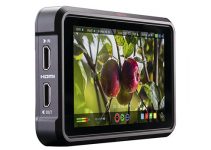Filmmakers are certainly not at a loss for camera choice. Up-and-coming brands are producing incredible models with increasing speed – it seems like there is a new exciting release every couple of weeks right now.
This isn’t solely at the low end, now we are seeing strong competition from brands like Blackmagic and Kinefinity that are challenging legendary brands like ARRI from a features perspective. And they are doing it at a fraction of the cost.
Filmmaker Wander Andringa, along with some studio support and friends, got their URSA Mini Pro 12K alongside an ARRI AMIRA and the Kinefinity MAVO. It’s going to be some comparison with these heavy hitters battling.
It’s important to point out that this is not a scientific test. It puts the camera in matched studio and daylight settings so we can check it out with some real footage.
As for settings, the URSA Mini Pro 12K is set to DCI 8K (8192 x 4320) in BRAW Q1, the ARRI AMIRA is recording at 3200 x 1800 ProRes 4444 XQ, and the Kinefinity MAVO is 6K (6016 x 3172) ProRes 4444 XQ. Also, the MAVO is using the Kinefinity Focal Enhancer, aka a 0.72x speed booster for a 1 stop improvement to light gathering.
All the images are corrected to match the ARRI Rec.709 color space and do not have any noise reduction applied. In front of the cameras are a selection of Leica primes. Those are going to look great on all the cameras and will standardize optics.
In the studio to start, the cameras all had the Leica Summicron 35m at f/2 with a white balance of 3200K, a sensitivity of ISO 800, and a 3-stop ND filter. I mean what can I say, they all look very good. With controlled lighting, beautiful lenses, and a cinema camera with excellent recording capabilities you can’t really go wrong.
To dig into it I think the first thing to look at is the sharpness. At full res and zoomed in you can easily pick out the ARRI with it’s relatively low resolution 3.2K sensor. Now’s the time to go watch the video because I’m going to throw out my guess.
I am going to go out and say that ARRI is camera B in this video. Another reason is the flashlight. Camera B appeared to have the best handle on it. The other two are closer, so I’ll save my guesses on that for later.
Same studio shot but now we are using a 50mm at f/4 with no ND. Being a bit closer up the detail differences do show up. Nothing too different from the previous test though. The colors all line up fairly well.
Next is where we might be able to pick out more differences as they begin to push the footage by underexposing by a couple stops. Now the noise is starting to come out. Unfortunately, YouTube compression destroys some of this – especially the 4 stops under takes – but I think we can glean a bit of information from this.
Camera A appears to have more fine noise and camera B has larger, but in some ways less problematic for future reduction. I’d hazard a guess now that camera A is going to be the Blackmagic. That means the C camera is the MAVO.
Moving outside is an entirely different story. I think here is where you can’t really make out the major differences. It’s impressive for two reasons.
It means Blackmagic is doing a quite stellar job with their recent releases that 12K sensor is particularly interesting and worthy of testing and that ARRI is still showing why they are constantly considering one of the best. The AMIRA is ancient in technology terms and is still just fine for video, unless you are shooting a Netflix original, unfortunately.
And the verdict is… what we were able to discern. A is Blackmagic, B is ARRI, and C is Kinefinity. I wish the MAVO showed up in all the tests, but it was nice to see it in the studio and show how more affordable brands are doing very well for themselves.
Andringa points out that the Ursa 12K holding its own and the similar grading style to ARRI makes it a great investment—plus you can’t hate on that extra resolution. He also thinks that the noise issues can be easily resolved in post.
Anyway, which camera did you think did the best? Think Blackmagic is gearing up to take the lead in pro cinema productions?
[source: Wander Andringa]
Order Links:
Disclaimer: As an Amazon Associate partner and participant in B&H and Adorama Affiliate programmes, we earn a small comission from each purchase made through the affiliate links listed above at no additional cost to you.



